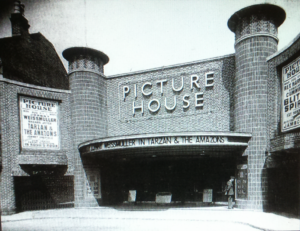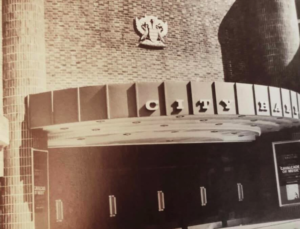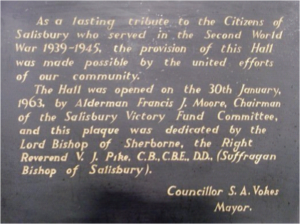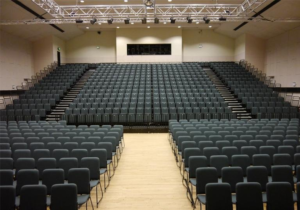
The Picture House in Fisherton Street which was later name The Odeon.
It eventually became Salisbury City Hall in 1963.
At the start of the 1960s Salisbury retained three apparently thriving cinemas – The Regal in Endless Street, The Odeon in Fisherton Street, and the Gaumont in the New Canal – indeed this had been the case for approaching a quarter of a century. However, during the decade national cinema attendances continued the trend of the late 1950s, dropping every year to hit a new low of 215 million in 1969. The Golden Age of cinema was passing and there were to be drastic changes in Salisbury.
The continuing decline in audiences placed CMA (Circuits Management Association) in a position whereby it was becoming impracticable for them to keep their Salisbury cinemas running in direct competition. At the Odeon attendances of as few as 50 people had become a regular occurrence and departing staff such as the doorman, boiler man and car park attendant were not replaced.
In 1961 CMA made the decision to axe one of the cinemas. Despite the luxurious surroundings of the Odeon in Fisherton Street, it was not particularly surprising that the decision was to retain the Gaumont in the New Canal, with its history and architecture, and a better location in the city centre. On 30 December 1961, the last Odeon feature was shown for the final time. Just as the cinema had opened with a Disney production (a Mickey Mouse short supporting King Solomon’s Mines) so it closed with another – One Hundred and One Dalmatians.
The Odeon Cinema in Fisherton Street was originally constructed in 1936 from a design by William Sidney Trent. It was named ‘The Picture House’ and later changed to ‘The Odeon’.
The site had previously been the old Griffin sawmills and timber yard together with part of the back garden of the Angel Hotel – it proved to be an ideal location being only a short walk from town centre and easily accessible to the population of the city. The most notable external feature was an attractive Art Deco frontage framed by twin brick pillars topped with ornate towers.
The Odeon officially closed on 31 December 1961 and was purchased by the City of New Sarum for conversion into a multi purpose civic hall, to be dedicated as a memorial to the local men and women who had served, and to those who had lost their lives during World War II.

Salisbury City Hall which opened in 1963. The front entrance originally opened up onto Fisherton Street
Extensive works were required to convert the cinema into a functional civic hall. The auditorium was re-modelled to provide a semi-sprung dance floor, tiered seating, a restaurant and smaller function room and a new main staircase. A pay box, bar and lounge area were installed in the foyer and entrance hall. The existing staircases were cut out to provide cloakroom and toilet facilities and a new scenery dock constructed at the stage end of the hall. The cost of purchasing and converting the building was £81,800, and this was met by the city’s Victory Fund, the public, plus additional funds built up over a number of years.
The hall was opened with an official luncheon on 30 January 1963. A plaque was unveiled in the foyer, which read ‘As a lasting tribute to the citizens of Salisbury who served in the Second World War 1939-45 the provision of this hall was made possible by the united efforts of our community’. The opening, dedication and luncheon was led by Alderman Francis Moore (the Chairman of the Victory Fund Committee), hosted by the Mayor and Corporation, and invited guests included officials and magistrates, representatives of the city’s business community and members of ex-service associations.

The memorial plaque dedicated to the citizens of
Salisbury who served in the Second World War 1939-45
Through the 1960s and early 1970s the City Hall hosted concerts by many of the most famous names in British music including The Beatles, Rolling Stones, Pink Floyd and Led Zeppelin. Concerts and comedy shows continued through subsequent decades, during which time many other events and dances, including wrestling and Salisbury Amateur Operatic Society productions were hosted.

The City Hall hosted the Beatles in 1963
Further physical changes were made to the building over the years. The hall was closed during the first national Covid -19 lockdown in 2020 and this operation continued until March 2023 – the hall is no longer a regional vaccination centre and is at present vacant.

The City Hall became a Covid vaccination centre in 2020
The future of the City Hall remains undecided but in a paper released on 11th October 2022 under the title of “Remobilisation of City Hall”, Wiltshire Council gave three proposals.
Option 1. Source a third party organisation to operate City Hall as an entertainment venue on behalf of Wiltshire Council.
Option 2. Wiltshire Council to manage and operate City Hall internally, using same model as prior to the venues closure in 2020.
Option 3. Sell/asset transfer venue to a suitable external organisation for use as an entertainment venue.
At the conclusion of this 13 page document the paper states “It is recommended that Option 1 be agreed, and Wiltshire Council seek to source an external organisation to operate the venue.” In my opinion, this WC recommended option might result in the alienation of local acts that, in the past, have used the City Hall as their favoured venue – Salisbury Operatic Society being one such group. Of the other two options, it seems obvious that WC regards the City Hall as a venue that loses money and therefore option 2 is a non-starter. Option 3. I personally think that the idea of selling Salisbury’s war memorial is ethnically wrong and an insult to the citizens of this city and our surrounding villages.
The idea of a hall being managed by a community group has also been mooted and although this would take a lot of organisational skill and management, it is well worth investigating. The one thing we don’t want is our City Hall demolished – we have lost numerous buildings and halls over the years and we shouldn’t add our City Hall/War Memorial to the list.
Salisbury City Hall – what is the future?
